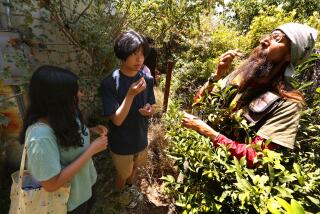High-Tech Explorers
- Share via
ANACAPA ISLAND — In 1542, Juan Rodriguez Cabrillo discovered Anacapa Island using the stars, a compass and quadrant.
In 1998, a group of Port Hueneme sixth-graders made the same nautical find with a digital camera, cell phone and a laptop computer.
What a difference 456 years make.
Eleven Hueneme Elementary School students, along with some of their parents and teachers, took a field trip Saturday to the island off Ventura County’s coast. Unlike most academic excursions, millions of others could have joined them.
As the group explored one of the eight Channel Islands, they photographed their discoveries and put them on an Internet site, showing in full color and nearly real time the wildlife and plants they found.
The trip was only the fifth organized by the Digital Exploration Society (DEX). The nonprofit club, based in La Canada Flintridge, hopes that such high-tech expeditions will become a regular occurrence and that schools across the United States will embrace the technology and the experiences it can provide.
“Eventually we’re going to be doing this all the time. We’re going to be walking, wireless people,” said Rob Lindstrom, a business journalist who founded DEX in January.
“I just want you to think of yourselves as real explorers,” Lindstrom told the students during the 90-minute boat ride from Channel Islands Harbor in Oxnard. “When you go out to the island, realize that your discoveries will go out to the whole world.”
But as with history’s great explorers, Saturday’s expedition was not without glitches. For the DEX crew, not being able to put the students’ photos on the Web was on par with Cabrillo making a wrong turn.
So as the students toured Anacapa with a park ranger, back at the island’s Visitors Center the DEX leaders tinkered with the equipment. They frantically tried different passwords and called tech-savvy friends in Los Angeles.
The whirring, glowing set-up that Richard Atkinson laid out on a weathered wooden bench included two laptops, two cellular phones and one of the six digital cameras used by the students. A solar power system for the National Park Service provided the juice.
“Part of the trick of this is these things do all integrate . . . but the challenge is they don’t integrate easily,” said Atkinson, who oversees communications technology for Northrup Grumman.
In the end, he and DEX co-founder Phil Merrill had to settle for seven photos from the boat trip over and the group’s first minutes on Anacapa. Additional postings to https://www.digitalexplorers.com were made when the group returned home, and the site will continue to be updated with the students’ written observations from their visit.
The sixth-graders clearly thought that the film-less cameras used on the field trip were cool and have about 400 pictures and 44 dead AA batteries to prove it.
But working or not, the laptop-phone-Web rig wasn’t nearly as interesting as the chicken bones they found or the pod of dolphins that followed them home.
Lindstrom said he wasn’t surprised that for 11-year-olds, technology is simply to be used and not for amazement. It is the adults who grew up long before the digital age who get excited about modem speeds and image resolution.
“Kids are almost completely disinterested in how the technology works,” he said. “They see technology in context automatically.”
Hueneme’s integration of technology into its curriculum is what drew DEX to invite the school on its fifth DEXpedition, which was made possible by a $1,200 grant from a Silicon Valley company and by cameras donated by their manufacturers.
“A lot of people think technology is superfluous. What we’re really looking for are the schools that think it’s integral,” Lindstrom said.
The students at Hueneme--where most classrooms are equipped with computers--will continue to use the information from the weekend field trip, teacher Maria Pallitto said.
“We will look this up on the Internet, that’s for sure,” she said.
That’s when Andres Sanchez predicts that the students will become more interested in the high-tech component of their seven-hour trip.
“Once they see their pictures on the Web site, they’ll go and explore it a lot more . . . because it’s personal to them,” said Sanchez, who was one of several adult chaperons who had to be shown by a sixth-grader how to use the cameras.
For Lindstrom and other leaders of the organization, all of whom work professionally with technology in some way, the expeditions are a way to experiment and discover new uses for today’s gadgets.
“In the history of technology,” Lindstrom said, “very often the best applications--the applications that make the technology really take off--come after the manufacturer.”
In using a digital camera and cell phone for the first time, Julie Lopez, 11, didn’t find any “killer apps,” but she did discover what it’s like to be on a boat.
“It’s just like a car, but it’s on the ocean,” said Julie, who won a $5 bet with her sister that she wouldn’t get seasick.
Her mother, Julia Lopez, had a good time too.
“My mom was actually crying because she had so much fun,” Julie said.
So whether the students were fascinated by the volcanic rock that formed the Channel Islands millions of years ago or the cutting-edge camera that may be obsolete within a year, Lindstrom considered Saturday’s trip a way to tomorrow’s explorers.
“I think we showed the kids what can be done.”
More to Read
Sign up for Essential California
The most important California stories and recommendations in your inbox every morning.
You may occasionally receive promotional content from the Los Angeles Times.










